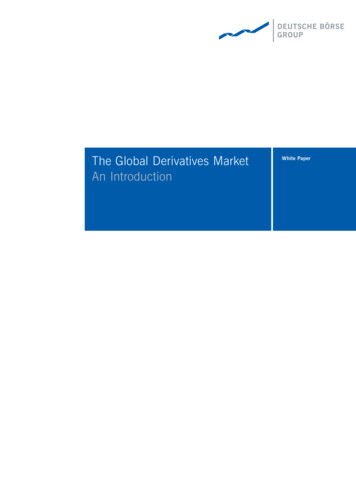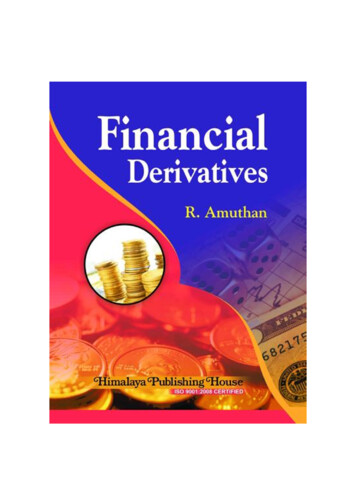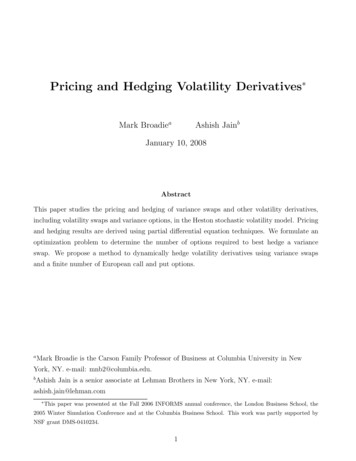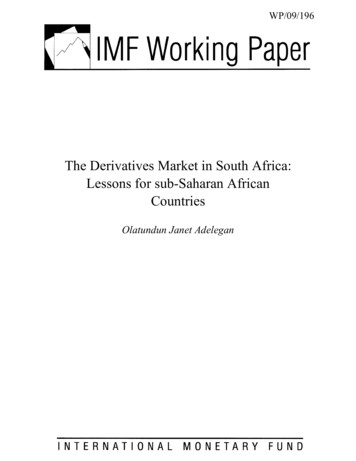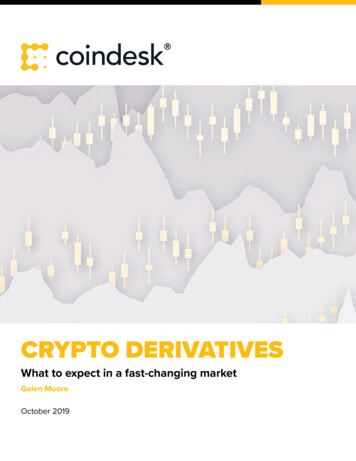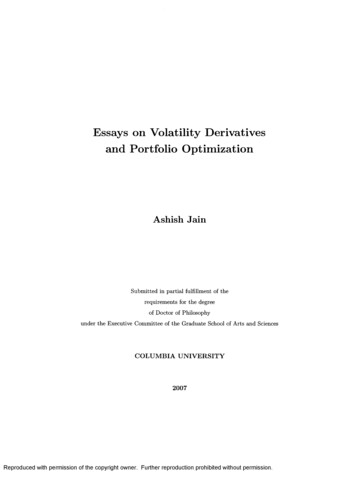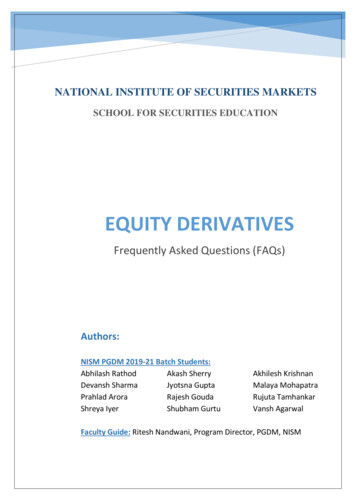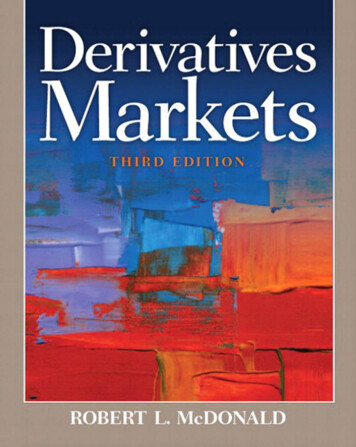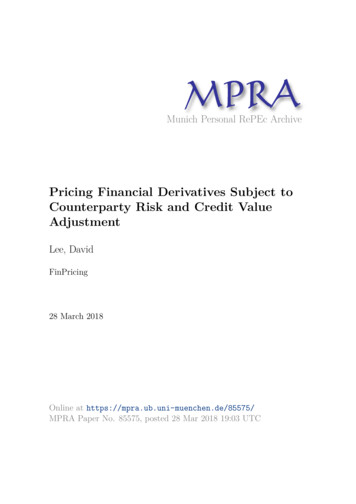
Transcription
Munich Personal RePEc ArchivePricing Financial Derivatives Subject toCounterparty Risk and Credit ValueAdjustmentLee, DavidFinPricing28 March 2018Online at https://mpra.ub.uni-muenchen.de/85575/MPRA Paper No. 85575, posted 28 Mar 2018 19:03 UTC
Pricing Financial Derivatives Subject toCounterparty Risk and Credit Value AdjustmentDavid Lee1FinPricingABSTRACTThis article presents a generic model for pricing financial derivatives subject to counterparty credit risk.Both unilateral and bilateral types of credit risks are considered. Our study shows that credit risk shouldbe modeled as American style options in most cases, which require a backward induction valuation. Tocorrect a common mistake in the literature, we emphasize that the market value of a defaultable derivativeis actually a risky value rather than a risk-free value. Credit value adjustment (CVA) is also elaborated. Apractical framework is developed for pricing defaultable derivatives and calculating their CVAs at aportfolio level.Key Words: credit value adjustment (CVA), credit risk modeling, risky valuation, collateralization,margin and netting.1Email: david.lee@finpricing.com; Url: http://www.finpricing.com
A broad range of financial instruments bear credit risk. Credit risk may be unilateral or bilateral. Somederivatives such as, debt instruments (e.g., loans, bills, notes, bonds, etc), by nature contain onlyunilateral credit risk because only the default risk of one party appears to be relevant. Whereas some otherderivatives, such as, over the counter (OTC) derivatives and securities financing transactions (SFT), bearbilateral credit risk because both parties are susceptible to default risk.In the market, risk-free values are quoted for most financial derivatives. In other words, creditrisk is not captured. Historical experience shows that credit risk often leads to significant losses.Therefore, it is obvious to all market participants that credit risk should be taken into account whenreporting the fair value of any defaultable derivative. The adjustment to the risk-free value is known asthe credit value adjustment (CVA). CVA offers an opportunity for banks to dynamically price credit riskinto new trades and has become a common practice in the financial industry, especially for trading books.By definition, CVA is the difference between the risk-free value and the true (or risky or defaultable)value that takes into account the possibility of default. The risk-free value is what brokers quote or whattrading systems or models normally report. The risky value, however, is a relatively less explored and lesstransparent area, which is the main challenge and core theme for credit risk measurement andmanagement.There are two primary types of models that attempt to describe default processes in the literature:structural models and reduced-form (or intensity) models. The structural models, studied by Merton(1974) and Longstaff and Schwartz (1995), regard default as an endogenous event, focusing on the capitalstructure of a firm. The reduced-form models introduced by Jarrow and Turnbull (1995) and Duffie andSingleton (1999) do not explain the event of default endogenously, but instead characterize itexogenously as a jump process. For pricing and hedging, reduced-form models are the preferredmethodology.Three different recovery models exist in the literature. The default payoff is either 1) a fraction ofpar (Madan and Unal (1998)), 2) a fraction of an equivalent default-free bond (Jarrow and Turnbull1
(1995)), or 3) a fraction of market value (Duffie and Singleton (1999)). The last one is most commonlyused in the market. In their paper, Duffie and Singleton (1999) do not clearly state whether the marketvalue of a defaultable derivative is a risky value or a risk-free value. Instead, the authors implicitly treatthe market value as a risky value because the market price therein evolves in a defaultable manner.Otherwise, they cannot obtain the desired result. However, most of the later papers in the literaturemistakenly think that the market value of a defaultable derivative is a risk-free value. Consequently, theresults are incorrect. For instance, the current most popular CVA model described by Pykhtin and Zhu(2007), and Gregory (2009) is inappropriate in theory because the authors do not distinguish risky valueand risk-free value when they conduct a risky valuation (i.e. valuing a defaultable derivative). In fact, themodel has never been rigorously proved.In this paper, we present generic models for valuing defaultable financial derivatives. Forcompleteness, our study covers various cases: unilateral and bilateral, single payment and multiplepayments, positive and negative payoffs. Although a couple of simple cases have been studied before byother authors, e.g. Duffie and Singleton (1999), Duffie and Huang (1996), who only provide heuristicderivations in a non-rigorous manner; analytic work on the other cases is novel. In contrast with thecurrent recursive integral solution (see Duffie and Huang (1996)), our theory shows that the valuation ofdefaultable derivatives in most situations requires a backward induction procedure.There is an intuitive way of understanding these backward induction behaviours: We can thinkthat any defaultable derivative with bilateral credit risk embeds two default options. In other words, whenentering a defaultable financial transaction, one party grants the other party an option to default and, at thesame time, also receives an option to default itself. In theory, default may occur at any time. Therefore,default options are American style options that normally require a backward induction valuation.We explicitly indicate that, within the context of risky valuation, the market value of a defaultablederivative is actually a risky value rather than a risk-free value, because a firm may default at any futuretime even if it survives today. An intuitive explanation is that after charging the upfront CVA, one alreadyconverted the market value of a defaultable derivative from the risk-free value to the risky value.2
From a practical perspective, we propose a novel framework to perform the bilateral riskyvaluation and calculate the bilateral CVA at a portfolio level, which incorporates netting and margin (orcollateral) agreements and captures wrong/right way risk.The rest of this paper is organized as follows: Basic setup is provided in Section 1; pricingunilateral defaultable derivatives and their unilateral CVAs is discussed in Section 2; valuing bilateralasymmetric defaultable derivatives and their bilateral CVAs is elaborated on in Section 3; a practicalframework that embraces netting agreements, margining agreements, and wrong/right way risk isproposed in Section 4, and the numerical results are presented in Section 5. The conclusions are given inSection 6.1. Basic SetupWe consider a filtered probability space ( , F , Ft t 0 , P ) satisfying the usual conditions,where denotes a sample space, F denotes a -algebra, P denotes a probability measure, and Ft t 0denotes a filtration.The default model is based on the reduced-form approach proposed by Duffie and Singleton(1999) and Jarrow and Turnbell (1994), which does not explain the event of default endogenously, butcharacterizes it exogenously by a jump process. The stopping (or default) time is modeled as a Coxarrival process (also known as a doubly stochastic Poisson process) whose first jump occurs at defaultwith a stochastic hazard rate or arrival intensity h(t ) .It is well-known that the survival probability, conditional on a realization path, from time t to s inthis framework is defined bysS (t , s ) : Pr( s t , Z ) exp h(u ) du t (1a)where Z is the firm-specific state process that helps forecast that firm’s default. The default probability,conditional on the realization path, for the period (t, s) in this framework is defined by3
sQ (t , s ) Pr( s t , Z ) 1 S (t , s ) 1 exp h(u ) du t (1b)Applying the law of iterated expectations, we express the expected survival probability for theperiod (t, s) ass S (t , s ) E exp h(u ) du F t t (2a)where E F t is the expectation conditional on the Ft . The expected default probability for the period(t, s) is expressed ass Q (t , s ) 1 S (t , s ) 1 E exp h(u )du F t t (2b)There are three different recovery models in the literature. The default payoff is either 1) afraction of par, 2) a fraction of an equivalent default-free bond, or 3) a fraction of market value. We usethe recovery model of market value in our study.The binomial default rule considers only two possible states: default or survival. For a discreteone-period (t, s) economy, at the end of the period a defaultable derivative either defaults with the defaultprobability Q(t , s) or survives with the survival probability S (t , s) . Assume that the market value of thedefaultable derivative at time s is V D (s) . The default payoff is a fraction of the market value given by (s)V D (s) , where (s) is the default recovery rate at time s, whereas the survival payoff is equal to themarket value V D (s) itself. Therefore, the risky value of the derivative, conditional on the realization path,is the discounted expectation of the payoffs, given by V D (t ) D(t, s) Q(t, s) (s)V D (s) S (t, s)V D (s) (3a)wheresD (t , s ) exp r (u )du t(3b)where D(t , s) denotes the stochastic risk-free discount factor at t for the maturity s and r (u ) denotes therisk-free short rate at time u ( t u s ).4
If the derivative survives at time s, the survival value is equal to the market value. However, thederivative may default at any time after s. Therefore, the present survival value or the market value attime s is a risky value. In other words, for risk-free valuations, the market value is a risk-free value, butfor risky valuations, the market value is actually a risky value. An intuitive explanation is that one alreadyconverted the market value from the risk-free value to the risky value after charging the upfront CVA.2.Unilateral Defaultable Derivatives Valuation and Unilateral CVAUnilateral risky valuation can be applied to two cases. By nature, the derivatives in case 1 involveonly unilateral credit risk. In case 2, the derivatives actually bear bilateral credit risk, but peoplesometimes may treat bilateral defaultable derivatives as unilateral ones for simplicity.Two parties are denoted as A and B. The unilateral credit risk assumes that only one party isdefaultable and the other one is default-free. In this section, we assume that party A is default-free,whereas party B is defaultable. All calculations are from the perspective of party A. Let the valuation datebe t. We study single payment cases first.2.1. Single Payment CasesConsider a defaultable derivative that promises to pay a X T from party B to party A at maturitydate T, and nothing before date T. The payoff X T may be positive or negative, i.e. the derivative may beeither an asset or a liability to each party. The risk-free value of the derivative at valuation date t is givenbyV F (t ) E D(t , T ) X T F t (4)where D(t,T ) is the risk-free discount factor defined in (3b).We divide the time period (t, T) into n very small time intervals ( t ) and assume that a defaultmay occur only at the end of each very small period.Proposition 1: The unilateral risky value of the single payment derivative is given by5
V D (t ) E C B (t , T ) X T F t (5a)where CB (t , T ) exp i 0 cB (t i t ) tn 1 c B (t i t ) r (t i t ) 1V D (t (i 1) t ) 0 hB (t i t ) 1 B (t i t ) (5b)(5c)where Y is an indicator function that is equal to one if Y is true and zero otherwise.Proof: See the Appendix.We may think of C B (t , T ) as the risk-adjusted discount factor and cB (u ) as the risk-adjusted shortrate. Here B (u ) represents the default recovery rate of party B, and hB (u ) represents the hazard rate ofparty B. s B (u) hB (u) 1 B (u) is called the credit spread or the short credit spread.Compared to the risk-free valuation (4), the risky valuation (5) is substantially complex. Theintermediate values are vital to determine the final price. For a small time interval, the current risky valuehas a dependence on the future risky value. Only on the final payment date T, the value of the derivativeand the maximum amount of information needed to determine the risk-adjusted discount factor arerevealed. This type of problem can be best solved by working backwards in time, with the later riskyvalue feeding into the earlier ones, so that the process builds on itself in a recursive fashion, which isreferred to as backward induction. The most popular backward induction valuation algorithms arelattice/tree and regression-based Monte Carlo.For an intuitive explanation, we can posit that a defaultable derivative under the unilateral creditrisk assumption has an embedded default option. In other words, one party entering a defaultable financialtransaction actually grants the other party an option to default. If we assume that a default may occur atany time, the default option is an American style option. American options normally have backwardrecursive natures and require backward induction valuations.6
In theory, a default may happen at any time. The Continuous-Time Risky Valuation Model, orsimply the Continuous-Time Model (CTM), assumes that a defaultable derivative is continuouslydefaultable. Proposition 1 can be further expressed in the form of the CTM as:Corollary 1.1: The unilateral risky value of the single payment derivative under the CTM is given by V D (t ) E C B (t , T ) X T F t (6a)whereTC B (t , T ) exp c B (u ) du t (6b)c B (u ) r (u ) 1V D (u ) 0 hB (u )(1 B (u ))(6c)The proof of this corollary becomes straightforward, according to Proposition 1, by taking thelimit as t approaches zero.Proposition 1 provides a general form for pricing a unilateral defaultable single paymentderivative. Applying it to a particular situation in which we assume that the payoff X T is non-negative,we derive the following corollary:Corollary 1.2: If the payoff X T is non-negative, the risky value of the single payment derivative under theCTM is given by V D (t ) E C B (t , T ) X T F t (7a)where T C B (t , T ) exp c B (u ) du t c B (u ) r (u ) hB (u)(1 B (u ))(7b)(7c)DThe proof of this corollary is easily obtained according to (6) by setting V (u) 0 . Since theDpayoff X T is non-negative, the intermediate value V (u) is also non-negative.7
Equation (7) is the same as Equation (10) in Duffie and Singleton (1999). In their heuristicderivation, the authors implicitly treat the market value of a defaultable derivative as a risky valuebecause the market price therein evolves in a defaultable manner. Otherwise, they would not have beenable to obtain the desired result.The risky valuation becomes quite simple when the payoff is non-negative. This corollary saysthat a single non-negative payment defaultable derivative can be priced using the present value of the promised payoff X T discounted by the risk-adjusted discount rate c B (u ) instead of the risk-free rater (u ) .By definition, the corresponding CVA of the single non-negative payment derivative can beexpressed as CVA U (t ) V F (t ) V D (t ) E D(t , T ) X T F t E C B (t , T ) X T F t (8) Since C B (t, T ) is always smaller than D(t , T ) , the CVA is, in this case, a credit charge. Thecredit charge covering party A’s potential loss comes from the scenario of party B’s default when party Ais in the money in the portfolio.Under the CTM, a unilateral defaultable derivative has an embedded American style defaultoption, which is continuously defaultable. Since American options are difficult to hedge, a commonpractice in the market is to use Bermudan options to approximate American ones. Consequently, weassume that a default may only happen at some discrete times. A natural selection is to assume that adefault may occur only on the payment dates. The Discrete-Time Risky Valuation Model, or simply theDiscrete-Time Model (DTM), assumes that a defaultable derivative may only default on payment dates.Proposition 2: The unilateral risky value of the single payment derivative under the DTM is given by V D (t ) E G B (t , T ) X T Ft (9a)where GB (t , T ) D(t , T ) 1 1 X T 0 QB (t , T ) 1 B (T ) (9b)8
Proof: See the Appendix.Here we may consider G B (t , T ) as the risk-adjusted discount factor. Proposition 2 states that theunilateral risky valuation of the single payoff derivative has a dependence on the sign of the payoff. If thepayoff is positive, the risky value is equal to the risk-free value minus the discounted potential loss.Otherwise, the risky value is equal to the risk-free value.The corresponding unilateral CVA of the single payment derivative under the DTM can beexpressed as CVA U (t ) V F (t ) V D (t ) E D(t , T ) X T F t E G B (t , T ) X T F t E 1 X T 0 D(t , T ) 1 B (T ) QB (t , T ) X T F t (10)Equation (10) shows that if the payoff is in the money, the CVA is a credit charge equal to thediscounted potential loss. If the payoff is out of the money, the CVA is zero.Proposition 2 has a general form that applies in a particular situation in which we assume that thepayoff X T is non-negative.Corollary 2.1: If the payoff X T is non-negative, the risky value of the single payment derivative under theDTM is given by V D (t ) E G B (t , T ) X T Ft (11a)whereGB (t, T ) D(t, T ) 1 QB (t, T ) 1 B (T ) D(t, T ) S B (t, T ) B (T )QB (t, T ) (11b)The proof of this corollary is straightforward according to Proposition 2 by setting X T 0 .Equations (11) are consistent with equations (3).2.2. Multiple Payments CasesSuppose that a defaultable derivative has m cash flows. Any of these cash flows may be positiveor negative. Let the m cash flows be represented as X 1 , , X m with payment dates T1 , , Tm . The riskfree price of the derivative is given by9
V F (t ) i 1 E D(t , Ti ) X i F tm (12)We divide any payment date period ( Ti 1 , Ti ) into n i very small time intervals ( t ) andassume that a default may occur only at the end of each very small period.Proposition 3: The unilateral risky value of the multiple payments derivative is given by V D (t ) i 1 E C B (t , Ti ) X i F tm (13a)wherei nk 1CB (t , Ti ) exp j k0 1 cB (t j t ) t c B (t j t ) r (t j t ) 1V D (t ( j 1) t ) 0 hB (t j t ) 1 B (t j t ) (13b)(13c)Proof: See the Appendix.Proposition 3 says that the pricing process of a multiple payments derivative has a backwardnature since there is no way of knowing which risk-adjusted discounting rate should be used withoutknowledge of the future value. In other words, the present value takes into account the results of all futuredecisions. On the final payment date, the value of a derivative and the decision strategy are clear.Therefore, the evaluation must be done in a backward fashion, working from the final payment datetowards the present. This type of valuation process is referred to as backward induction.If we model default in a continuous-time setting, the Proposition 3 can be further expressed asfollows.Corollary 3.1: The unilateral risky value of the multiple payments derivative under the CTM is given by V D (t ) i 1 E C B (t , Ti ) X i F tm (14)whereTiC B (t , Ti ) exp c B (u ) du t(14b)c B (u ) r (u ) 1V D (u ) 0 hB (u )(1 B (u ))(14c)10
The proof of this corollary is easily obtained, according to Proposition 3, by taking the limit as t approaches zero.Proposition 3 has a general form that applies in a particular situation in which we assume that allthe payoffs are non-negative.Corollary 3.2: If all the payoffs are non-negative, the risky value of the multiple payments derivativeunder the CTM is given by mV D (t ) i 1 E C B (t , Ti ) X i F t (15a)where Ti C B (t , Ti ) exp c B (u ) du t (15b) c B (u ) r (u ) hB (u)(1 B (u ))(15c)DThe proof of this corollary is straightforward, according to (14), by setting V (u) 0 .This is the formula for pricing defaultable bonds in the market. Corollary 3.2 says that if all thepayoffs are positive, we can evaluate each payoff separately and sum the corresponding results. In otherwords, payoffs in this case can be treated as independent.If we assume that a default may occur only on the payment dates, the result is the followingproposition in a discrete-time setting.Proposition 4: The unilateral risky value of the multiple payments derivative under the DTM is given byV D (t ) i 1 Em i 1j 0 G B (T j , T j 1 ) X i F t (16a)where t T0 and GB (T j , T j 1 ) D(T j , T j 1 ) 1 1( X V D (T )) 0 QB (T j , T j 1 ) 1 B (T j 1 ) j 1j 1(16b)Proof: See the Appendix.11
Similar to Proposition 3, the individual payoffs under Proposition 4 cannot be evaluatedseparately. The current risky value depends on the future risky value. This type of problem is usuallysolved using backward induction algorithms.Proposition 4 has a general form that applies in a particular situation where we assume that allpayoffs are non-negative.Corollary 4.1: If all the payoffs are non-negative, the risky value of the multiple payments derivativeunder the DTM is given byV D (t ) i 1 Em i 1j 0 G B (T j , T j 1 ) X i F t (17a)Where t T0 and G B (T j , T j 1 ) D(T j , T j 1 ) 1 Q B (T j , T j 1 ) 1 B (T j 1 ) (17b)The proof of this corollary is easily obtained according to Proposition 4 by setting Xj 1 V D (T j 1 ) 0 .3. Bilateral Defaultable Derivative Valuation and Bilateral CVAA critical ingredient of the pricing of a bilateral defaultable derivative is the rules for settlementin default. There are two rules in the market. The one-way payment rule was specified by the earlyInternational Swap Dealers Association (ISDA) master agreement. The non-defaulting party is notobligated to compensate the defaulting party if the remaining market value of the derivative is positive forthe defaulting party. The two-way payment rule is based on current ISDA documentation. In the event ofdefault, if the contract has positive value to the non-defaulting party, the defaulting party pays a fractionof the market value of the derivative to the non-defaulting party. If the contract has positive value to thedefaulting party, the non-defaulting party will pay the full market value of the derivative to the defaultingparty. Within the context of risky valuation, one should consider the market value of a defaultablederivative as a risky value.12
The default indictor j for party j (j A, B) is a random variable with a Bernoulli distribution,which takes value 1 with default probability Q j , and value 0 with survival probability S j . Consider a pair of random variables ( A , B ) that has a bivariate Bernoulli distribution as summarized in Table 1.Table 1. Bivariate Bernoulli Distribution This table shows the joint and marginal distributions of a bivariate Bernoulli distribution of A and B . Marginally, each random variable j ( j A , B ) follows a univariate Bernoulli distribution that takesvalue 1 with default probability Q j and value 0 with survival probability Sj. QA S AQB S B where is the correlation coefficient of A and B .Joint DistributionJoint Distribution A 1 A 0Marginal Distribution B 1QB Q A QB S A QB B 0S B QA SB S A SBQASAMarginal Distribution3.1. Single Payment CasesConsider a defaultable derivative that promises to pay a X T from party B to party A at maturitydate T and nothing before date T. The payoff may be either an asset or a liability to each party.We divide the time period (t, T) into n very small time intervals ( t ) and assume that a defaultmay occur only at the end of each very small period.Proposition 5: The bilateral risky value of the single payment derivative is given by V D (t ) E O(t , T ) X T F t (18a)where13
n 1O(t , T ) exp i 0 o(t i t ) t o(t i t ) r (t i t ) 1V (t (i 1) t ) 0 pB (t i t ) 1V (t (i 1) t ) 0 p A (t i t )(18b)(18c)p B (t i t ) 1 B (t i t ) hB (t i t ) 1 B (t i t ) h A (t i t ) 1 B (t i t ) B (t i t ) AB (t i t ) h A (t i t )hB (t i t ) 1 hB (t i t ) t 1 h A (t i t ) t (18d) hB (t i t )h A (t i t ) t p A (t i t ) 1 A (t i t ) h A (t i t ) 1 A (t i t ) hB (t i t ) 1 A (t i t ) A (t i t ) AB (t i t ) h A (t i t )hB (t i t ) 1 hB (t i t ) t 1 h A (t i t ) t (18e) hB (t i t )h A (t i t ) t Proof: See the Appendix.We may think of O(t, T ) as the bilateral risk-adjusted discount factor and o(u) as the bilateralrisk-adjusted short rate; j (j A, B) represents the default recovery rate of party j, i.e. the fraction of themarket value paid by the defaulting party j when the market value is negative for j; h j represents thehazard rate of party j; j represents the non-default recovery rate of party j, i.e. the fraction of the marketvalue paid by non-defaulting party j when the market value is negative for j. j 0 represents the oneway settlement rule, while j 1 represents the two-way settlement rule. denotes the defaultcorrelation coefficient of A and B. AB denotes the joint recovery rate when both parties A and B defaultsimultaneously.For any time interval ( u , u t ), the bilateral risk-adjusted short rate o(u) has a switching-typeDdependence on the sign of future value V (u t ) . Similar to Proposition 1, the valuation process givenby Proposition 5 builds on itself in a backward recursive fashion and requires a backward inductionvaluation.14
Proposition 5 provides a general form for pricing a bilateral risky single payment derivative.Applying it to a particular situation in which we assume that parties A and B do not defaultsimultaneously and have independent default risks, i.e. 0 and AB 0, we derive the followingcorollary.Corollary 5.1: If parties A and B do not default simultaneously and have independent default risks, thebilateral risky value of the single payment derivative under the CTM is given by V D (t ) E O (t , T ) X T F t (19a)whereTO (t , T ) exp o (u )du t (19b)o (u ) r (u ) 1V D (u ) 0 pB (u ) 1V D (u ) 0 p A (u )(19c)p B (u ) 1 B (u ) hB (u ) 1 B (u) hA (u )(19d)p A (u ) 1 A (u ) hA (u ) 1 A (u ) hB (u )(19e)The proof of this corollary becomes straightforward according to Proposition 5 by setting 02and AB 0, taking the limit as t approaches zero, and having hB (u)hA (u) t 0 for very small t .Corollary 5.1 is the same as equation (2.5’) in Duffie and Huang (1996), but their derivation isheuristic rather than rigorous.The corresponding bilateral CVA of the single payment derivative in this case can be expressedas CVA B (t ) V F (t ) V D (t ) E D(t , T ) X T F t E O (t , T ) X T F t (20)Since O (t , T ) is always smaller than D(t,T ) , the bilateral CVA may be positive or negativedepending on the sign of the payoff. In other words, the CVA may be either a credit charge or a creditbenefit. A credit charge that is the value of a default loss comes from the scenario of one’s counterparty15
defaulting when one is in the money, while a credit benefit is the value of a default gain in the scenario ofone’s own default when one is out of money.If we assume that a default may occur only on the payment dates, the default options becomeeither European options or Bermudan options.Proposition 6: The bilateral risky value of the single payment derivative under the DTM is given by V D (t ) E Y (t , T ) X T Ft (21a)where Y (t , T ) D(t , T ) 1XT 0 yB (t , T ) 1XT 0 y A (t , T ) yB (t , T ) S B (t , T ) S A (t , T ) B (T )QB (t , T ) S A (t , T ) B (T ) S B (t , T )QA (t ,T ) AB (T )QB (t ,T )QA (t ,T ) (t , T ) 1 B (T ) B (T ) AB (T ) y A (t , T ) S B (t , T ) S A (t , T ) A (T )QA (t ,T ) S B (t , T ) A (T ) S A (t , T )QB (t , T ) AB (T )QB (t , T )QA (t ,T ) (t , T ) 1 B (T ) B (T ) AB (T ) (t ,T ) S B (t ,T )QB (t ,T ) S A (t ,T )QA (t ,T )(21b)(21c)(21d)(21e)Proof: See the Appendix.We may think of Y (t , T ) as the risk-adjusted discount factor. Proposition 6 tells us that thebilateral risky price of a single payment derivative can be expressed as the present value of the payoffdiscounted by a risk-adjusted discount factor that has a switching-type dependence on the sign of thepayoff.Proposition 6 has a general form that applies in a particular situation where we assume thatparties A and B do not default simultaneously and have independent default risks, i.e. 0 and AB 0.Corollary 6.1: If parties A and B do not default simultaneously and have independent default risks, thebilateral risky value of the single payment derivative under the DTM is given by V D (t ) E Y (t , T ) X T Ft (22a)where16
Y (t , T ) D(t , T ) 1 X T 0 y B (t , T ) 1 X T 0 y A (t , T ) (22b)yB (t ,T ) SB (t ,T )S A (t ,T ) B (T )QB (t ,T )S A (t ,T ) B (T )SB (t ,T )QA (t ,T )(22c)y A (t ,T ) SB (t ,T )S A (t ,T ) A (T )QA (t ,T )SB (t ,T ) A (T ) S A (t ,T )QB (t ,T )(22d)The proof of this corollary is easily obtained according to Proposition 6 by setting 0 and AB 0.3.2. Multiple Payments CasesSuppose that a defaultable derivative has m cash flows. Let the m cash flows be represented asX 1 , , X m with payment dates T1 , , Tm . Each cash flow may be positive or negative.We divide any payment date period ( Ti 1 , Ti ) into n i very small time intervals ( t ) andassume that a default may occur only at the end of each very small period
The adjustment to the risk-free value is known as the credit value adjustment (CVA). CVA offers an opportunity for banks to dynamically price credit risk into new trades and has become a common practice in the financial industry, especially for trading books. By definition, CVA is the difference between the risk-free value and the true (or .
